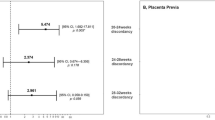Abstract
Background
This study aimed to evaluate the usefulness of the first-trimester crown-rump length (CRL) and nuchal translucency (NT) discordance in monochorionic diamniotic twins (MCDA) for the prediction of complications—twin–twin transfusion syndrome (TTTS), selective fetal growth restriction (sFGR) or intrauterine fetal demise (IUFD).
Methods
Intertwin discordance in the CRL and NT was calculated as a percentage of the larger CRL and NT, respectively. The performance of inter twin discordance (CRL ≥ 10% and NT≥ 20%) for predicting complications was analysed using standard statistical screening test methods.
Results
Fifty-eight MCDA twin pregnancies were studied. Out of them, 19 (32%) pregnancies resulted in one of the complications studied (4 TTTS, 10 sFGR, 5 IUFD). CRL and NT discordance showed an increased probability of developing complications positive likelihood ratio (LR+) {95% confidence interval}: 2.05 {0.46–9.23} and 1.88 {1.03–3.45}, respectively. NT discordance showed a sensitivity of 57%.
Conclusions
Although discordant first-trimester CRL and NT in monochorionic twins are poor screening tools for early prediction, if positive, they increase the risk of developing complications.




Similar content being viewed by others

References
Fichera A, Prefumo F, Stagnati V, et al. Outcome of monochorionic diamniotic twin pregnancies followed at a single center. Prenat Diagn. 2015;35(11):1057–64.
Kilby MD, Bricker L, On behalf of the Royal College of Obstetricians and Gynaecologists. Management of monochorionic twin pregnancy. BJOG. 2016;124:e1–45.
Khalil A, Rodgers M, Baschat A, et al. ISUOG practice guidelines: role of ultrasound in twin pregnancy. Ultrasound Obstet Gynecol. 2016;47:247–63.
ACOG. Multifetal gestations: twin, triplet, and higher-order multifetal pregnancies. Practice Bulletin no. 169. Obstet Gynecol. 2016;128:e131–46.
FASP. Fetal anomaly screening programme. London: Crown. https://assets.publishing.service.gov.uk/government/uploads/system/uploads/attachment_data/file/443865/FASP_ultrasound_handbook_July_2015_090715.pdf (2015). Accessed 14 May 2020.
National Collaborating Center for Women’s and Children’s Health (UK). Twin and triplet pregnancy. Commissioned by the National Institute for Clinical Excellence. 2019.
Kontopoulos E, Chmait RH, Quintero RA. Twin-to-twin transfusion syndrome: definition, staging, and ultrasound assessment. Twin Res Hum Genet. 2016;19(3):175–83.
Khalil A, Beune I, Hecher K, Reed K, et al. Consensus definition and essential reporting parameters of selective fetal growth restriction in twin pregnancy: a Delphi procedure. Ultrasound Obstet Gynecol. 2019;53(1):47–54.
Mackie FL, Whittle R, Morris RK, et al. First-trimester ultrasound measurements and maternal serum biomarkers as prognostic factors in monochorionic twins: a cohort study. Diagn Progn Res. 2019;3:9.
Mackie FL, Hall M, Morris R, et al. Early prognostic factors of outcomes in monochorionic twin pregnancy: systematic review and meta-analysis. Am J Obstet Gynecol. 2018;219(5):436–46.
Stagnati V, Zanardini C, Fichera A, et al. Early prediction of twin-to-twin transfusion syndrome: systematic review and meta-analysis. Ultrasound Obstet Gynecol. 2017;49:573–82.
Mogra R, Saaid R, Tooher J, et al. Prospective validation of first-trimester ultrasound characteristics as predictive tools for twin-twin transfusion syndrome and selective intrauterine growth restriction in monochorionic diamniotic twin pregnancies. Fetal Diagn Ther. 2020;47:321–7.
Management of monochorionic twin pregnancy. The Royal Australian and New Zealand College of Obstetricians and Gynaecologists. https://ranzcog.edu.au/RANZCOG_SITE/media/RANZCOG-MEDIA/Women%27s Health/Statement and guidelines/Clinical-Obstetrics/Management-of-Monochorionic-Twins-(C-Obs-42)-review-July-2017.pdf?ext = .pdf (2017). Accessed 14 May 2020.
Funding
No funding sources.
Author information
Authors and Affiliations
Corresponding author
Ethics declarations
Conflict of interest
The authors declare that they have no conflict of interest.
Ethical approval
Written informed consent is taken from all the patients, visiting our centre, about the use of their personal data for future studies. Also for doing reanalysis of de-identified data permission was taken from the Institutional ethics committee.
Additional information
Publisher's Note
Springer Nature remains neutral with regard to jurisdictional claims in published maps and institutional affiliations.
Dr. Saloni Arora, MD, MRCOG, Fellowship Fetal Medicine, Consultant, Apollo Centre for Fetal Medicine, New Delhi, India. Dr. Smriti Prasad, MD, MRCOG, Fellowship Fetal Medicine, Consultant, Apollo Centre for Fetal Medicine, New Delhi, India. Dr. Akshatha Sharma, MD, MRCOG, Fellowship Fetal Medicine, Consultant, Apollo Centre for Fetal Medicine, New Delhi, India. Dr. Anita Kaul, MD, FRCOG, Diploma in Fetal Medicine, Clinical Coordinator and Head of Department, Apollo Centre for Fetal Medicine, New Delhi, India.
Rights and permissions
About this article
Cite this article
Arora, S., Prasad, S., Sharma, A. et al. First-Trimester Crown-Rump Length (CRL) and Nuchal Translucency (NT) Discordance in Monochorionic Twins: An Ominous Sign or a Benign Feature?. J Obstet Gynecol India 70, 349–354 (2020). https://doi.org/10.1007/s13224-020-01354-0
Received:
Accepted:
Published:
Issue Date:
DOI: https://doi.org/10.1007/s13224-020-01354-0



